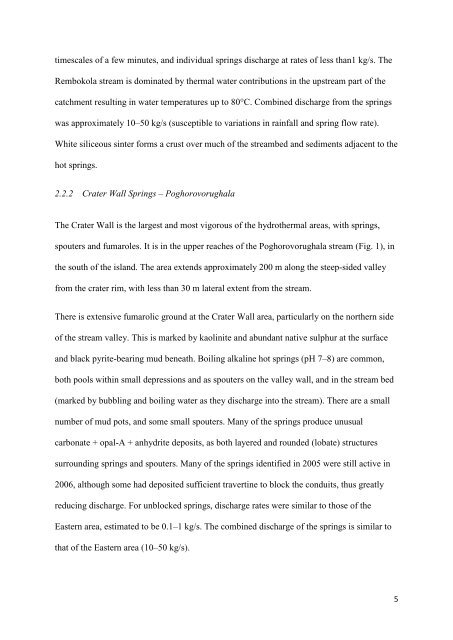Alkaline sulphate fluids produced in a magmatic hydrothermal system
Alkaline sulphate fluids produced in a magmatic hydrothermal system
Alkaline sulphate fluids produced in a magmatic hydrothermal system
Create successful ePaper yourself
Turn your PDF publications into a flip-book with our unique Google optimized e-Paper software.
timescales of a few m<strong>in</strong>utes, and <strong>in</strong>dividual spr<strong>in</strong>gs discharge at rates of less than1 kg/s. The<br />
Rembokola stream is dom<strong>in</strong>ated by thermal water contributions <strong>in</strong> the upstream part of the<br />
catchment result<strong>in</strong>g <strong>in</strong> water temperatures up to 80°C. Comb<strong>in</strong>ed discharge from the spr<strong>in</strong>gs<br />
was approximately 10–50 kg/s (susceptible to variations <strong>in</strong> ra<strong>in</strong>fall and spr<strong>in</strong>g flow rate).<br />
White siliceous s<strong>in</strong>ter forms a crust over much of the streambed and sediments adjacent to the<br />
hot spr<strong>in</strong>gs.<br />
2.2.2 Crater Wall Spr<strong>in</strong>gs – Poghorovorughala<br />
The Crater Wall is the largest and most vigorous of the <strong>hydrothermal</strong> areas, with spr<strong>in</strong>gs,<br />
spouters and fumaroles. It is <strong>in</strong> the upper reaches of the Poghorovorughala stream (Fig. 1), <strong>in</strong><br />
the south of the island. The area extends approximately 200 m along the steep-sided valley<br />
from the crater rim, with less than 30 m lateral extent from the stream.<br />
There is extensive fumarolic ground at the Crater Wall area, particularly on the northern side<br />
of the stream valley. This is marked by kaol<strong>in</strong>ite and abundant native sulphur at the surface<br />
and black pyrite-bear<strong>in</strong>g mud beneath. Boil<strong>in</strong>g alkal<strong>in</strong>e hot spr<strong>in</strong>gs (pH 7–8) are common,<br />
both pools with<strong>in</strong> small depressions and as spouters on the valley wall, and <strong>in</strong> the stream bed<br />
(marked by bubbl<strong>in</strong>g and boil<strong>in</strong>g water as they discharge <strong>in</strong>to the stream). There are a small<br />
number of mud pots, and some small spouters. Many of the spr<strong>in</strong>gs produce unusual<br />
carbonate + opal-A + anhydrite deposits, as both layered and rounded (lobate) structures<br />
surround<strong>in</strong>g spr<strong>in</strong>gs and spouters. Many of the spr<strong>in</strong>gs identified <strong>in</strong> 2005 were still active <strong>in</strong><br />
2006, although some had deposited sufficient travert<strong>in</strong>e to block the conduits, thus greatly<br />
reduc<strong>in</strong>g discharge. For unblocked spr<strong>in</strong>gs, discharge rates were similar to those of the<br />
Eastern area, estimated to be 0.1–1 kg/s. The comb<strong>in</strong>ed discharge of the spr<strong>in</strong>gs is similar to<br />
that of the Eastern area (10–50 kg/s).<br />
5
















